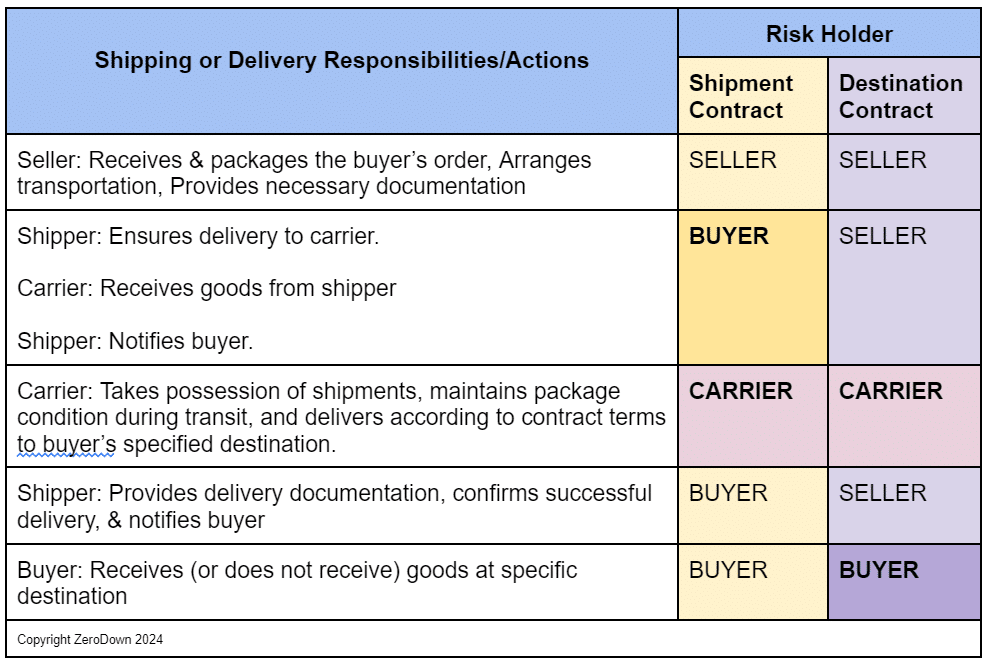A shipping contract is a legally binding agreement between a shipper and a carrier that details the terms of cargo transport, including responsibilities, shipment handling, and payment. This document is essential for ensuring the safe and efficient transportation of goods and for resolving any disputes that may arise.
This article delves into the complexities and key components of shipping contracts to help you navigate these vital trade agreements.
Key Takeaways
-
Definition: A shipping contract outlines rates, fees, responsibilities, and liabilities between shippers and carriers, covering risk allocation, delivery obligations, and price terms.
-
Regulation: Governed by laws and regulations such as those from the International Maritime Organization (IMO), shipping contracts ensure adherence to international standards and provide mechanisms for dispute resolution.
-
Components: Key elements include clear definitions of each party’s roles and responsibilities, detailed shipping costs, and terms defined by Incoterms to govern the delivery of goods in international trade.
Deciphering the Shipping Contract

If you’re a business doing any type of shipping, then shipping contracts come along with the package–no pun intended! As a business, you must pay carriers to help move your goods. Anytime shipping is involved, carriers are involved–and therefore, a carrier contract.
In order to solidify this exchange, shippers and carriers negotiate contracts outlining the nature of their relationship. Once negotiated, the final shipping contract is a written, mutual agreement serving as a guide, insurance, and means of holding all parties accountable to agreed-upon terms.
Ultimately, shippers and carriers–important parts of the supply chain alone–rely on each other to be successful; without proper shipping contracts and relationships, the supply chain becomes a dead end.
What is a Shipping Contract?
A shipping contract, also known as a carrier contract, defines the relationship between the shipper and the carrier, outlining the roles and expectations of each party involved. It allocates risk, delivery obligations, and price terms, shaping the shipping process.
Shipping contracts perform the primary functions of:
-
Solidifying the relationship between parties and logistical scope of the contract.
-
Defining responsibilities and liabilities, including insurance stipulations and when the responsibility for the safety of the goods transfers from the shipper to the carrier.
-
Outlining agreed-upon rates and/or fees between parcel carriers and shippers for transporting packages.
-
Agreeing upon procedures for addressing any issues such as damage, loss, or late delivery of shipments.
The goal when negotiating for a shipping contract is to secure terms that offer the best value of price and efficiency. A robust shipping agreement includes all necessary details and is carefully customized for the specific relationship between carrier and shipper.
The Parties Involved in a Shipping Contract

A shipping contract involves multiple stakeholders, including the buyer, seller, and carrier, each with specific roles and responsibilities.
Roles of the Seller:
Responsible for timely delivery of goods, providing accurate shipment data, ensuring permits are in order, and adhering to packaging requirements.
Roles of the Buyer:
Seeks cost-effective and timely delivery of goods, providing accurate information and ensuring compliance with relevant permits and regulations.
Roles of the Carrier:
Responsible for taking possession of shipments, maintaining package condition during transit, and delivering according to contract terms. They are liable for the shipment from the time they take possession until delivery.
Types of Shipping Contracts

Shipping contracts come in various types, each with unique rules and specifications. The primary types of contracts you’ll be engaging with are shipment contracts and destination contracts.
The primary difference between Shipment and Destination contracts is which party holds the risk of loss prior to risk transfer to the buyer, and when that final transfer occurs. In the case of loss, these terms dictate the party responsible for accrued costs.

Shipment Contracts
In a shipment contract, the risk of loss shifts from the seller to the buyer when the goods are delivered to the carrier. While it is the seller’s responsibility to get goods to the carrier along with proper documentation and notification, as soon as goods change hands from seller to carrier, the buyer assumes the risk–regardless of whether the goods are subsequently lost or damaged before they physically take possession.
Businesses stand to benefit more from this type of arrangement by removing responsibility from the entire “final mile” leg of delivery, which is where many instances of damage or loss occur. On the other hand, this type of contract may lower customer satisfaction if something does happen to their items.
Most customers expect refunds or compensation for damage or loss–regardless of when it happens. While under a shipment contract companies are not mandated to respond accordingly, but could develop a perception of poor rapport or reputation.
Destination Contracts
Under a destination contract, the seller retains the risk of loss until the goods reach the buyer’s specified destination. The seller’s responsibilities include delivering the goods to the designated location and providing the necessary delivery documents.
Destination contracts have their own unique dynamics. Under a destination contract, the seller retains the risk of loss for goods in transit for additional legs of the journey beyond reception by the carrier. This means the seller remains liable for any issues arising with the goods during transit.
This dynamic safeguards the buyer’s interests, ensuring a smooth and risk-free delivery until the successful handover of the goods. However, it’s the more financially costly option for sellers, especially if selling items that may be more susceptible to damage, theft, or loss.
Key Components of a Shipping Contract
Several key components add clarity and structure to a shipping contract.
Risk Allocation
Every shipping operation has its risks, for carriers and shippers alike. Risk allocation is the practice of recognizing and naming those risks, and settling upon mutually agreed terms about which party takes on the burden of that risk, should issues occur.
Carriers and shippers might take into consideration:
-
Liability for violating insurance, terms, legal regulations
-
Liability for lost, stolen, or damaged goods, late delivery
-
Pricing risk/rate volatility based on supply/demand, fuel costs, regulations
-
Carrier service risk/capacity constraints
-
Fraudulent carriers
-
Impact of labor disputes, strikes, high demand
-
Unexpected natural disasters, geopolitical, supply chain disruptions
A common example of risk allocation in shipping contracts is a Free Carrier (FCA) Designation, a clause stating that risk passes from the shipper to the carrier upon delivery of the goods to the carrier. This protects shippers from liability of goods in transit.
Allocating risk in your shipping contract is all about balance, and requires trust and transparency. While contracts are traditionally static, it’s increasingly more popular to adopt dynamic models, allowing space for fluctuation in the volatile market. Ultimately, the more collaborative and clear your risk allocation in your shipping contract, the more net beneficial the outcome.
Price Terms
No shipping contract is complete without settling upon price terms. How much will the shipper pay the carrier for transporting goods?
The balance between rates and costs is crucial for fulfilling the shipper’s and consignee’s needs for cost-effectiveness and timeliness.
Payment terms must be explicitly stated to avoid misunderstandings.
Calculating Shipping Costs in Shipping Contracts
Shipping costs and terms in shipping contracts are influenced by factors such as:
-
Package dimensions.
-
Package Weight and/or Package Volume. Carriers calculate shipping costs based on the greater of actual weight vs dimensional weight (DIM), which considers the package’s volume.
-
Destination.
-
Desired delivery speed.
One way for shippers to lower their rates is by optimizing their packaging. If your product only weighs 2 lbs, but you ship it in a box 2x the size, you run a big risk of paying more because of the DIM…essentially, paying for air!
ZeroDown’s package optimization service lowers costs by using statistics and data to calculate the exact ideal package dimensions that balance safety, maximize packages per shipment, and avoids costly empty space.
Challenges Negotiating Carrier Rates in Shipping Contracts
Price negotiations can be sources of possible tension in a shipping contract, because carriers have a monopoly on the shipping market. They know the shipper needs them regardless.
The only competition carriers have is other carriers–making it easy to inflate rates. Because of this, it’s in carriers’ best interest to withhold information like industry standard rates from shippers when developing a shipping contract.
Shippers can protect themselves from getting less-than-ideal carrier rates on their shipping contracts in a few ways, all of them hinging on knowledge and preparation:
-
Engage with experienced industry professionals who have insider connections
-
Collect extensive internal data to determine current expenses, shipping goals, and budget
-
Conduct statistical analysis of historical rates data & engage tools for predictive analytics on expected market trends
Shippers can get this type of information and support through advanced software and automations, like FreightOptics’ integrated data collection tool, paired with expert guidance and brokering, by professionals at ZeroDown who understand the technology, data, and shipping contract negotiation tactics.
Compliance & Permits in shipping contracts
Understanding International Commercial Terms
Incoterms, or International Commercial Terms, are a set of 11 standardized rules created by the International Chamber of Commerce to clearly define the responsibilities of sellers and buyers for the delivery of goods in international trade.
Parties can agree to use any version of Incoterms in their contract as long as it is clearly stated. For instance, the Incoterm FCA (Free Carrier) specifies that the transfer of goods is to the designated carrier, marking a crucial point in the responsibility shift.
Legal Enforceability of Shipping Contracts
Shipping contracts are legally binding documents regulated by national laws and International Maritime Organization (IMO) regulations. These laws ensure that shipping operations comply with international standards and provide methods for dispute resolution.
With the exception of a limited few countries who have ratified a newer alternate 2009 UN Convention called the “Rotterdam Rules,” the vast majority of countries follow the “Hague-Visby Rules” and/or “Hamburg Rules,” conventions from 1924 and 1968 respectively, which standardize a framework governing the rights and obligations of parties in shipping by sea.
Under these conventions, parties are allowed to choose which law and jurisdiction they will adhere to in their contract. In a shipping contract, this is called the Choice of Law Clause, which dictates the laws that will determine the rights and obligations of the involved parties. If not specified, international courts will determine the governing law.
Clear Shipping, Delivery, and Payment Provisions
Shipping Restrictions
These detail limitations on delivery locations or the types of goods that can be shipped, contributing to a comprehensive image of the shipping agreement.
Moreover, carrier contracts require shippers to comply with specific packaging types, weight limitations, and accurate weight reporting. Optimizing these factors can lead to reductions in shipping costs.
Delivery Obligations:
A sound shipping agreement ensures explicit delivery and payment provisions, including handling time, rates, discounts, and minimum spend requirements. Compliance with packaging types, weight limitations, and accurate reporting can reduce costs.
The responsibilities concerning the packaging, loading, and unloading of goods, which can often be contentious issues, should also be agreed upon by the parties.
Moreover, the inclusion of detailed information on the expected condition of goods upon arrival helps prevent conflicts. These include the seller’s responsibility to deliver products according to schedule and the carrier’s obligation to transport goods safely and efficiently.
Similarly, delivery obligations in a shipping contract include the responsibility of the seller to deliver products as per a schedule and for carriers to transport goods safely and expediently.
Navigating Insurance and Claims in Shipping Contracts
Insurance in Shipping Contracts
Insurance and claims act as protective measures against loss or damage during transit.
The party responsible for insuring the goods is often determined in a shipping contract by shipping terms like FOB or CIF.
-
Free on Board (FOB): Indicates whether the seller or buyers os liable for goods that are damaged or destroyed during shipping
-
Cost, Insurance, and Freight (COF): International maritime shipping agreement stating that the seller pays for insurance and transport of goods to the buyer.
What is Shipping Insurance?
While clauses for risk allocation are an essential method of dividing up liabilities, they aren’t the only way to protect goods. Many shippers also seek shipping insurance, beyond the shipping contract.
Shipping insurance protects goods from risks like theft, deterioration, and mishandling. It generally does not cover issues like improper packaging, mishandling in transit, and delays.
There are various types of shipping insurance available, including:
-
Carrier insurance offered by shipping companies
-
Third-party insurance from independent insurers
-
Self-insurance maintained by the seller
-
International insurance for overseas shipments
-
All risk insurance providing comprehensive coverage.
Brokers like ZeroDown are invaluable in navigating complicated insurance terms and procedures by building sound, beneficial clauses into your shipping contract.
Considering Shipping Insurance to Counter Carrier Liability Limitations
Shippers, especially those with expensive goods, face concerns like carrier liability limitations, based on the declared value of the items.
Declared value answers the question: How much do the items inside each package cost you, the shipper? For carriers, declared value answers the question: How much could we be liable per package if something happens?
Most carriers protect themselves in shipping contracts with carrier liability restrictions, or a maximum amount they would be liable for ($100 is a common number). Most will also have a maximum total liability cap, usually around $50,000.
Shippers can get additional, separate protection through Shipping insurance, which typically ranges from 1.5% to 4% of the declared value of the items. Insurance providers like ZeroDown can ensure full coverage of actual shipment value, add coverage beyond carrier liability, and are managed with separate claims as opposed to with the carrier.
Claim Procedures and Dispute Resolution in Shipping Contracts
A claims procedure is the process of seeking resolution for issues, such as loss or damage, that arise in a shipment. Claims could be filed by the buyer against the carrier or shipper; by the carrier against the shipper; or by the shipper against the carrier.
What claims may be filed, why, by whom, and against whom, are all itemized in the shipping contract.
For example:
-
Choice of Law clause will dictate which laws to follow for disputes
-
FOB or CIF insurance clauses will indicate the liable party for insuring goods
-
Risk allocation names possible issues and predetermined actions
-
Delivery and shipping restrictions are a reference for following expectations
Shipping Contracts typically outline a clear claims filing process that requires the buyer to inspect the goods upon delivery and inform the seller or carrier about any losses or damages within a prescribed timeframe.
As the shipping contract states, they also typically include clauses outlining the dispute resolution methods to be used, such as arbitration or litigation, in the event of a disagreement over a claim.
Crafting a Solid Shipping Contract

Creating a robust shipping contract requires:
-
Precise language
-
Clear delivery and payment provisions
-
Effective negotiation of favorable terms
-
Definitions of technical terms
-
Obligations of each party
-
Explicitly stated delivery timelines
This will help avoid ambiguity and ensure long-term success.
It’s important to note that shipping contracts may be amended, but such amendments should be in writing and signed by all parties to ensure they are enforceable.
Negotiating Favorable Terms for Long-Term Success
Successful negotiation balances shipping options and costs, focusing on service levels, shipping volume, and surcharges. Effective negotiation fosters long-term relationships and ensures smooth operations.
Maintaining positive relationships with carriers and focusing on more than just price, such as service levels, shipping volume, and surcharges, is crucial for long-term success in shipping services. Brokers like Zero Down know how critical relationship-building is, and as carrier contract brokers come to the table with thousands of contracts under their belt.
Negotiate for Solid Shipping Contracts
Shipping contracts guide the journey of goods from seller to buyer, defining roles, responsibilities, risk allocation, and delivery terms. Understanding these contracts is crucial for successful transactions and long-lasting business relationships.
Brad McBride, CEO and Founder of Zero Down Supply Chain Solutions is a dynamic leader with over 30 years of experience in the supply chain sector. His journey began at Consolidated Freightways in 1988, where he mastered freight logistics and pricing. His career led him to Eagle Global Logistics, diving into international freight forwarding and leading high-volume shipping projects.
Read More




